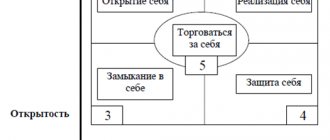The essence and functions of interpersonal communication
A communicative act always consists of at least two partners who are connected by a single information space. In the process of communication, a person transmits information to a partner; in social psychology he is called a “communicator.” The partner who receives and interprets information is the recipient .
Interpersonal communication
A form of communication in which individuals play the roles of both communicator and recipient.
Interpersonal communication is characterized by direct contact between the subjects of communication, which determines a number of features of this form of communication: close feedback that regulates the course of communication; the wealth of codes used, including non-verbal ones; two-way exchange of information that occurs in the form of dialogue.
According to the nature of interaction, one can consider personal, role, group interpersonal communication. The first has a more expressive nature, associated with the self-expression of the “I”.
Role-based interpersonal communication is characterized by:
- significant degree of formalization;
- its content is determined by the role relationships of the partners;
- its goal is to achieve a certain result, which often does not depend on the desires and aspirations of the participants in communication.
Group communication
This is a form of communication in which at least one subject of communication is a social group.
Group communication is quite common. It exists in the activities of public relations workers. For example, the press secretary of the city mayor holds a press conference or briefing for journalists, a public relations department - working with teams of departments of the company, a presentation of a small shop, an open day at an educational institution, an excursion for schoolchildren or students.
The role-based variety of interpersonal communication, along with group communication, constitutes the main communication system in organizations. The specifics of interpersonal communication are determined by the active nature of the human personality, which constitutes this process. In human communication, there is not just a “movement of information”, but an active exchange of it.
Communication process and its role
The communication process is an exchange of information carried out between two or more individuals. Its purpose is to ensure the understanding and transmission of information that is the subject of exchange.
We transmit and receive information in order to:
- inform other people about something (for example, a press release or teletext);
- warn others (shouting or road signs);
- explain something (textbook);
- entertain (feature film or joke);
- convince someone (a poster calling for something);
- describe something (oral story or documentary).
These are the goals of communication. Most often, there are several of them within one process. For example, a film can inform, entertain, warn, describe, and explain.
Types of barriers in communications
Communication barrier
This is a psychological obstacle of various origins that the recipient places in the way of unwanted or dangerous information.
Barriers to communication can arise through the individual psychological characteristics of those communicating.
The most common barriers to interpersonal communication :
- avoidance (avoiding contact with unwanted persons, forgetting;
- authority (devaluation of information by reducing the authority of the communicator);
- semantic barrier, jargon, slangs;
- stylistic barrier;
- logical barrier. The communicator must choose a system of evidence that is adequate for the given moment.
Communication functions
Since the time of Aristotle, thinkers have noted that the process of communication can manifest itself in different ways. Its essence depends on internal and external environmental conditions, declared and true goals of the parties, the number of participants, strategies and means of execution, etc. The functions of communication should be determined taking into account the influence of numerous factors on it. In the real process of transmitting messages, even in one communicative act, several functions are sometimes combined. Moreover, one or two of them are decisive, basic. We can also talk about the functions of this communication in general, that is, about what its role is in the life and activities of society and people.
As a rule, communication functions are isolated only for the purposes of applied scientific or research analysis. For example, this is necessary for consulting activities. An interaction model can be built by determining which functions are primary and which are secondary.
Removing barriers
Improving organizational communications and eliminating barriers in organizations is facilitated by:
- Streamlining the communication process.
- Effective use of graphics.
- The most effective method of improving communications is filtering information.
- Barriers caused by the perception of information. To eliminate this barrier, the position (installation) of the recipient should be clarified and adjusted to the transfer of information.
- To eliminate semantic barriers caused by different understandings of the symbols exchanged between the sender and recipient of information, employees need to avoid narrow professional jargon and acquire a culture of speech.
- To eliminate nonverbal barriers that arise as a result of incorrect interpretation by participants in the communicative process of eye expression, facial expressions, gestures, intonation, voice modulation, etc., it is necessary to be able to “read” people by their nonverbal signals.
- Learn to listen and convey information from participants in the communication process.
- It is necessary to provide sufficient information.
- Wrong psychological attitude. To overcome a stereotype of thinking, when forming a message, you need to remember, firstly, that the message must be thought through and have confidence that it is not distorted by a stereotype, and secondly, determine what stereotype the recipient has and how to construct the message so that the recipient was not influenced by the stereotype.
- Improving feedback.
- Increasing the efficiency of information accounting.
Within each management system, it is necessary to select methods for improving communications that will correspond to the culture of the organization, its technical potential, and the degree of importance of tasks at a certain stage of development. Constant modification of communication links is necessary to strengthen mutual understanding between employees of the organization and form its positive image in the environment.
Channel and decoder
It is also necessary to consider such a concept as a channel. It is a means of transmitting information (meetings, written communications, oral communications, telephone conversations, reports, memos, computer networks, email, etc.).
A decoder (decoding) is a type of message transformation by the recipient. These are the same tools and methods that are used in encoding, only in this case they are used in the opposite direction.
Communication models
To date, many communication models have accumulated in educational and specialized literature. Most of them were described by researchers in the 20th century. However, Aristotle proposed the first model known to us. Based on it, one can determine the tasks, functions of communication and its meaning. In his works “Rhetoric” and “Poetics”, the thinker presented the following model: “speaker-speech-listener”. He pointed out that this classical model is universal, as it fully reflects the act of communication in both written and oral forms.
However, in the first half of the 20th century, when mass media such as cinema, radio, and television began to develop, the classical model was slightly modified. In the 21st century, due to the development of computer technology, economic integration and political globalization, this model requires an even more in-depth interpretation. Once again, researchers are faced with the task of determining the main functions of mass communication.
Definition of the concept
What do we mean by the term "communication"? If we talk about this concept in simple language, it means communication in its various manifestations. And if this had not happened, it is impossible to imagine how a person would live.
The word “communication” comes to us from the Latin language. In it, communication means “transfer” or “message”. That is, communication in a general sense is understood as the exchange of information that occurs between interlocutors. It is also the transmission of a message from one person to another.
Types and forms of communication are very different, speech and non-speech. People, even without speaking, are able to communicate with each other using symbols, facial expressions or gestures. There is also written communication.
It becomes clear that if the transfer of information between several participants in a conversation turns out to be ineffective for some reason, then people will never be able to reach an agreement among themselves. In other words, various types of communications are the basis for the existence and activities of any organization.
Principles of Effective Communication
- The principle of consistency.
Semantic correspondence between the information received and the response. For example, a greeting requires a return greeting. A question should be answered, not another question. In this way, each speech fragment will have a conclusion.
- The principle of preferential structure.
Confirming and rejecting responses are given differently. Consent is usually expressed without delay, extremely concisely and clearly.
The boss asks the subordinate: “The report must be submitted by tomorrow”
The subordinate replies: “Okay.”
Disagreement is accompanied by a preliminary pause, followed by a more voluminous response, including arguments and explanations.
Boss: “Analyze the department’s weekly statistics by evening.”
Subordinate: “(pause) I would love to complete this assignment, but right now I’m busy with the previous task.”
A sender who knows the principles of effective communication will hear a pause of disagreement after a request and soften the request.
Boss: “Analyze the weekly statistics for the department by evening and then you can leave work early tomorrow.”
Such a conversation will get rid of unnecessary tension, and the order will be completed.
- The principle of cooperation.
Consists of 4 groups of postulates: quality, quantity, attitude, method.
Quality: “The statement must be true.”
Quantity: “The statement must contain no less and no more information than required”
Attitude: “Stay on topic.”
Method: “Be clear.”
Paraverbal communications
The meaning of the speech spoken by a person can change depending on the intonation with which he pronounced this or that phrase, as well as the timbre of the voice used to convey sound symbols. Based on this, the interlocutor’s emotions, his confidence or uncertainty, etc. become clear. Such means are classified as paraverbal. They include in their list a set of those sound signals that accompany oral speech and allow us to see additional meanings in it.
An example of paraverbal communications is the utterance of a phrase with a questioning intonation, with sarcasm, with humor, with disgust, etc. That is, in this case, information is transmitted from person to person thanks to vocal tones, which are given a certain meaning in the languages of various nations. With such speech, any spoken word will never become neutral. Moreover, how a person says sometimes becomes more significant than what he says.
What makes paraverbal communications work? This type of information transfer uses the mechanism of human associations. It is thanks to him that our intellect restores facts obtained in the past, comparing them with those that exist at the present time. The effect of a phrase uttered during paraverbal communication is achieved due to the creation by the speaker of a common information field of interaction. The latter allows the interlocutor to understand his partner. At the same time, such communication achieves the greatest effect using the following means:
- Speech speed. When speaking in a manner that is lively and lively, while maintaining a fast pace of pronunciation of phrases, one can talk about the impulsive nature of the interlocutor and his confidence in his own abilities. Conversely, a slow and calm manner of speech will indicate prudence, equanimity and thoroughness of the speaker. If there are noticeable fluctuations in the speed of the text, we can talk about slight excitability, uncertainty and imbalance of the person.
- Volume. Well-heard speech can indicate the sincere motives of the interlocutor or his complacency and arrogance. Quiet speech indicates modesty, tact and restraint, or a lack of vitality. Significant changes in the volume of spoken phrases indicate excitement and emotionality of the interlocutor. Based on data from communicative practice, increased emotionality of speech sometimes leads to a lack of logic in it.
- Articulation. With clear and precise pronunciation of words, we can talk about the internal discipline of a person. If the speech is vague and unclear, then most likely the interlocutor is compliant and has a sluggish will.
- Voice pitch. Very often, falsetto is characteristic of the person whose speech and thinking are most based on the intellect. A chesty voice is a sign of increased emotionality. If a person pronounces phrases shrilly, this indicates his excitement and fear.
- Speech mode. With the rhythmic repetition of spoken phrases, we can talk about the good mood of the interlocutor, his balance and richness of feelings. With an angular, abrupt manner of speech, a person expresses his anxiety.
All of the above means of paraverbal communication are designed to evoke certain emotions in the partner, as well as feelings of experience, which leads to the achievement of certain intentions. Similar results can also be achieved using pauses and coughs, laughter and sighs, crying and other means of communication that use the voice.
Communication is not just communication...
The roots of the basic concept go back to the Latin word “communication”, which appeared thanks to another word – “communicare”. The first means “ communication, connection ,” and the second means “to communicate, connect, make common.”
The general meaning, it would seem, is clear, but this initial meaning inevitably changed over the course of time and the development of social interaction. It has changed and acquired a slightly different color, which served as the basis for additional interpretations.
So, in particular, based on the definition of “communicare” (to report, connect), communication implies the process of transmitting messages and other signals, and in the modern understanding - the transfer of information or the exchange of knowledge and information between objects of any nature (both natural and artificial) .
On the other hand, there is the etymology of “communication”, which goes back to the concepts of community and association, which occupy a special place in the system of socio-philosophical theories and humanitarian discourses (how is that?). In this perspective, associations, societies and communities are seen either as a goal or as a condition for successful communication.
As for philosophy, issues of communication become particularly relevant only at the beginning of the 20th century. This “belated, but subsequent” reaction of society to this topic is explained by the sharp aggravation of social problems and the need to solve them. And it is precisely during this period that the meaning of the term in question is concretized.
The bottom line is that we get a simple and understandable thesis:
communication is a constructive process of interaction between people or their groups for the purpose of transmitting information or exchanging information.
This definition most accurately reflects the essence of communication and is considered official, however, taking into account different angles, there are other formulations, of which only two are the most common.
In the first, communication is interpreted as the main mechanism that allows creating social connections and improving social culture, and in the second - as the laws of interpersonal interaction that govern people’s relationships.
Main types of communication
With the most general division of ways of transmitting information from person to person, they are divided into verbal and non-verbal. These types of communications use different sign systems. That is why it is so difficult to describe the process of information transmission itself, which characterizes the variety of signals used.
There are three types of intercultural communication. These include verbal, nonverbal, and paraverbal. How are they different from each other?
By verbal communication we mean the transfer of information in words. This is a process in which one person speaks and the other listens. As for non-verbal communication, it occurs due to the existence of a system of signs called “opticokinetic”. In this case, pantomime, facial expressions and various gestures would be appropriate.
If we analyze the main types of communication, non-verbal communication processes differ in that when they are carried out, different tone and intonation are appropriate, and there is also eye contact between the interlocutors. This method of communication makes it possible to externally express a person’s inner world, and also indicates his level of personal development.
In paraverbal communication, sound signals are simultaneously used to accompany a person’s speech and add some additional meaning to it. In this case, the meaning of what is said changes based on the intonation of the speaker, the timbre and rhythm of his voice, as well as on logical and phrasal stress.
Diversity of communication
So, this process is observed not only in human society. Communication is also characteristic of animals (the language of bees, capercaillie mating, mating dances of birds) and of mechanisms, that is, objects created by man (sewage, pipelines, telephone and telegraph signals, transport). Communications of a special kind can be observed even in inanimate nature. For example, it is carried out between some plants.
In particular, the African acacia, releasing special enzyme compounds into the surrounding space, informs other acacias about the invasion of a giraffe, which eats tree shoots. The leaves of trees that have received this information quickly acquire qualities that, from the animal’s point of view, are characteristic of inedible food. The process described above is characterized by the basic functions of communication and its characteristics. This means that it can be characterized by the term that interests us.
We briefly described the concept, role, and functions of communication. The material presented above reveals the main aspects of this topic.
Functions of business communication
Knowledge of the core functions of business communications will help you achieve effective implementation in business, climb the career ladder, and become successful.
Verified business communications between subjects (management, partners, employees) will demonstrate how well and appropriately the company will develop and projects will be implemented in a timely manner.
There are three primary functions of business communications: informational, regulatory, affective and communicative. The information communication function involves the accumulation, production, broadcast and reception of messages. In the process of communicative interaction, not only the movement of information occurs, but also the mutual transmission of encrypted data between two subjects of communication. It follows that information is exchanged. However, at the same time, subjects do not just exchange definitions, they strive to develop a common meaning. Developing a common meaning is possible only if information is accepted and then comprehended. During the exchange of messages, communication barriers may appear, which may have psychological or social background.
The information itself coming from the communicator can be stimulating, i.e. serving as incentives for any action, and ascertaining, taking place in different educational systems.
To be broadcast, any message must be encrypted. Those. Data transfer is possible only using language sign systems. This is the main function of language in communication.
The regulatory communicative function lies in adjusting behavior and also contains methods of influencing a partner, for example, suggestion or persuasion. That is, it characterizes such components of communications that are directly and closely related to the interaction of individuals and the organization of their collective activities. The affective-communicative function lies in the formation of the emotional shell of the personality. In other words, this is a process of acceptance and comprehension by subjects of each other.
All of the listed functions of communication are closely interrelated, harmoniously complement each other and represent the communicative process as a whole.
The need for information transfer
Through interaction with each other, people try to provide themselves with a more convenient and easier life. For example, a person can ask someone else for something, complain about a particular situation, and also receive useful information for themselves.
Using various types of communications, people exchange the facts at their disposal. Social and mass, marketing and non-verbal, business and many other types of communication have a similar direction.
During a conversation, people can take different positions in relation to their interlocutor. That is why the characteristics of the type of communication will depend on what roles a person chooses for himself. Thus, a dictator cannot help but treat everyone condescendingly. His statements are characterized by a commanding tone, uncompromising decisions and issued orders. As for his interlocutor, to create an ideal match, he must be pliable, submissive, quiet and amenable to influence. If people change their positions or do not strive to play the role assigned to them, then disputes will certainly arise during the conversation.
Using various types of communications, people adapt to each other in communication. Thus, the same person speaks with some interlocutors in a commanding voice, with others he is friendly, and with others he prefers to be completely silent. The whole point is precisely what he is like, this second person. In the same case, if someone communicates with all people in the same way, then the interlocutors will adapt to him.
In addition to these, there are many more types of social communication. All of them will depend on the character and habits, desires and goals, skills and position of a person in society, as well as fears, complexes and other aspects that each interlocutor has.









